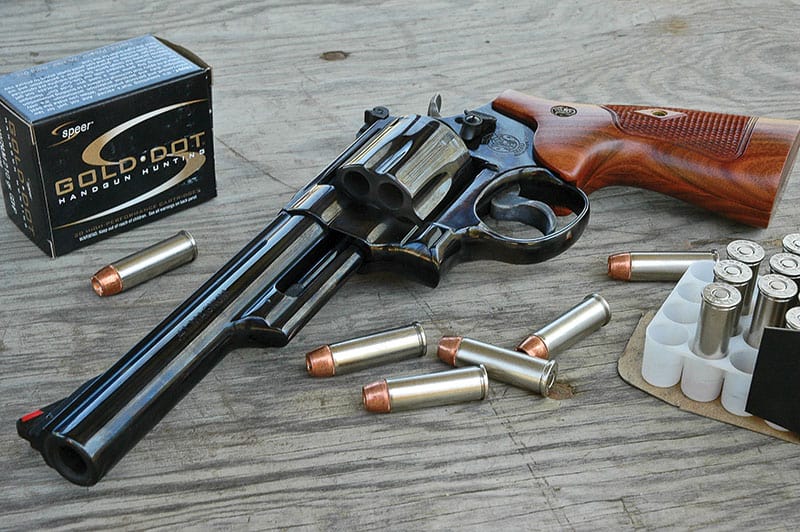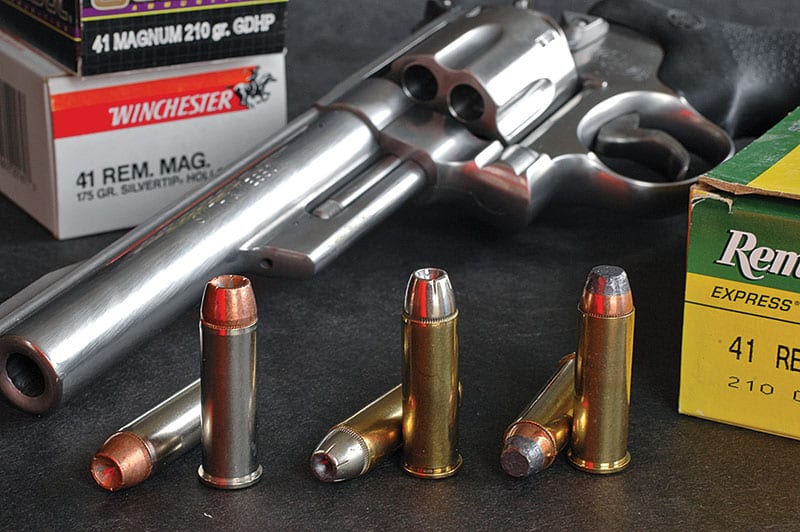In 1836 Colt established his Patent Arms Manufacturing Company in Paterson, N.J. The .34-caliber Paterson had a folding trigger and no loading lever. You had to carry a ramrod or change cylinders to reload. A .36-bore version became the Texas Paterson after Ranger Jack Hayes and his troops used it to swat an imposing swarm of hostile Comanches.
The panic of 1837 caused economic recession. In 1841 the Paterson plant closed. Five years later though, a visit from Texas Ranger Samuel Walker turned Colt’s attention back to revolvers. The resulting Walker Colt was a 4-1/2-pound .44, manufactured briefly at Ely Whitney’s factory. Captain Walker fell to a Mexican lance soon thereafter at the Battle of Juamantla. The Dragoon was a smaller, refined Walker .44 named after pre-Civil War cavalry. An even more compact .31 arrived in 1848, and a Pocket Model a year later. The 1851 .36 Navy earned fame in the hands of Wild Bill Hickok, who packed a pair, but it lacked the punch of the Dragoon. One grizzly hit repeatedly by .36 balls collapsed at last to a .44 Dragoon.
Despite the obvious advantages of cartridge firearms, notably Colt’s 1873 Single Action Army, the cap-and-ball revolver saw use long after their debut. Pony Express riders initially holstered two Colt Navys, 86-grain bullets atop 25 grains of black powder. Weight concerns later nixed the second pistol. Meanwhile, lawmen and outlaws shifted to bigger bullets. On August 2, 1876, Jack McCall snuck up behind Wild Bill during a card game in Deadwood and shot him in the head with a Colt .45. McCall fled west but was caught in Wyoming, returned to the Dakotas and hanged.
The .41 Magnum Story
The "Just Enough" Magnum
When black powder drove patched balls, frontiersmen saved lead by reducing bore size. Rifles on the Ohio and the Cumberland had slender barrels, commonly under .50 caliber. On the plains, bison and grizzlies were not impressed; Hawken rifles hurled beefier payloads. But the first handguns carried into the hard-edged West launched lightweight balls. Small-bore pistols made sense partly because steels and mechanisms of the day wouldn’t endure heavy charges. Also, rate of fire mattered more than power for up-close defense against brigands, often coming in multiples.
One of the earliest repeating handguns followed the purchase of Walter Hunt’s Volitional ring-lever rifle by New York financier Courtlandt Palmer. In 1854 Palmer formed a gun company with Horace Smith and Daniel Wesson. They soon announced volcanic pistols in .41 (and .31) caliber. Despite claims that “30 charges can be loaded and discharged in 50 seconds,” these guns languished at market. Late that year, Smith & Wesson sold to investors who incorporated it as Volcanic Repeating Arms. Oliver F. Winchester would steer it, and rifles would become its future.
Meanwhile, Samuel Colt was making handguns. Just 15 when he’d fashioned an underwater mine in 1829, he went to sea a year later. Legend has it he got the notion of a revolving cylinder from the ship’s wheel. Back in Massachusetts, family friend Henry Ellsworth helped Colt file a patent.
Pocket Pistols And Grizzlies
The .41 bore resurfaced in Colt’s Model 1877, arguably the first commercially successful double-action revolver — arguably because its mechanism was famously troublesome. Sold in nickel or with cased frame and blued barrel, it came in .32 Colt, .38 Long Colt and .41 Long Colt. Though the company didn’t name them, distributor Benjamin Kittredge attached the tags “Rainmaker,” “Lightning” and “Thunderer.” (He’s also credited with dubbing the SAA the “Peacemaker.”) Billy the Kid and John Wesley Hardin among other miscreants favored the .41 Thunderer to single-action Colts. Factory loads sent 200-grain outside-lubricated bullets from this .41 at 730 fps, for 230 foot-pounds of muzzle energy.
During the 1890s, smokeless powder gave all bullets more muscle; but in 1905 Smith & Wesson fashioned a revolver for a .44 Special black-powder load (26 grains that drove a 246-grain bullet through nine 7/8″ pine boards!). The .44 Hand Ejector appeared in 1907. The first .44 Military Model of 1908 became the “Triple Lock,” as it latched at the breech, ahead of the extractor rod and between the yoke and extractor shroud. A Second Model followed. Customer demand brought the shroud and heavy lug back to the Third Model (of 1926). The Fourth Model (1950 Target) had a ribbed barrel, adjustable rear sight and short-throw hammer. By this time, S&W had adapted its N-Frame revolver to other cartridges.
Magnums!
The 5″ .38/44 Heavy Duty debuted in 1930, firing high-velocity .38 Special ammunition not suitable in lighter frames. The .38/44 Outdoorsman with adjustable sights followed. Then, at the urging of Phil Sharpe, S&W and Winchester Repeating Arms collaborated on a new round with a case 1/8″ longer than the .38 Specials. Its 158-grain .357 bullet clocked over 1,500 fps and delivered nearly twice the muzzle energy of the .44-40! Still, S&W forecast modest sales and designed the new N-Frame as a custom revolver. It appeared in 1935, priced at $60 ($15 more than most popular S&Ws). Each .357 Magnum was boxed with a registration certificate and zeroed at 200 yards. But S&W had underestimated demand; the slated monthly production of 120 guns fell far short. In 1938 the certificate went away as ace pistoleer Ed McGivern baptized the Model 27 by hitting man-size targets to 600 yards!
On the heels of the second world war, an Idaho cowboy began crusading for a revolver cartridge to upstage the .357. Elmer Keith’s .44 Special handloads in his S&W 1950 Target set the stage for the .44 Magnum, in a hull 1/8″ longer. In 1954 Remington presented S&W with factory loads driving 240-grain bullets at 1,350 fps, effectively doubling the blow of the .45 Colt. S&W added steel to its 1950 frame, hiking pistol heft from 40 to 47 ounces. The Model 29 .44 Magnum revolver went public in 1956.
In June, 1963, Remington came up with a more civil N-Frame cartridge to serve hunters and law officers. The .41 Magnum fired a .410 bullet, not a .386 like the old .41 Long Colt. The police load, with a 210-grain bullet at about 1,000 fps, was noticeably less violent than 210-grain JHPs at 1,300. The first Model 57 revolver came in blue or nickel finish, with target grips and adjustable sights. S&W listed barrel lengths of 4″, 6″ and 8-3/8″. The fixed-sight, standard-grip service version, the Model 58, followed in 1964. S&W dropped the 58 in 1977, 16 years before abandoning the 57. A stainless 657 arrived in 1991. S&W’s Paul Pluff recalls a .41 with 6-1/4″ barrel, unfluted cylinder. Roughly 2,500 of these Classic Hunters were built. In 1995 the 657 re-appeared with 6″ ported barrel and fluted cylinder. “We called that the Magnum Hunter,” says Paul. Subsequently, the firm built a 3″ 657 (1998), then a 4″ 57 Trail Gun (2005). S&W has since included .41 Magnum revolvers in its Classics stable.
But the .44 Magnum, smug for a time as the world’s most powerful revolver cartridge, had a firm grip on headlines. A natural first pick for hunters after big game, it appeared in Ruger’s Super Blackhawk revolver in 1959. Dirty Harry gave it a huge boost on screen. Meanwhile, Dick Casull loaded the .45 Colt to case-cracking pressures in stout single-actions. The resulting .454 Casull (a 1983 introduction) kicked 260-grain bullets downrange at 1,800 fps, and 300s at 1625. Sturdy new Freedom Arms revolvers bottled the 60,000 psi.
Exactly Enough
I like the .41 for much the same reasons I favor the .30-06. It’s enough without being too much. A mid-weight .41 revolver (40 to 48 ounces), like a 7-pound .30-06, is easy to carry and, with practice, easy to control. No ear-splitting brake necessary. While the range of factory loads in .41 Magnum can’t match the ’06, it’s adequate. From a 4″ barrel, 175-grain Winchester Silvertips pace 240-grain Platinum Tips from a 6″ tube. Remington advertises a 210 softpoint at 1,300; Speer’s 210 Gold Dot HP clocks the same over my Oehler sky-screens (which, by the way, register speeds 30 to 40 fps shy of factory values for the .41). Federal lists 180-grain Barnes Expanders at 1,340 fps, 210 Swift A-Frames at 1,360, 250 CastCores at 1,160.
While the 5″ barrels I prefer are scarce on .41 Magnum revolvers, this cartridge shows plenty of muscle in 4″ guns. I used S&W 58 and 57 revolvers, with 4″ and 6″ barrels respectively, to run some velocity comparisons. Save for a Remington sample in the 6″ barrel, no standard deviation exceeded 30. Five-shot groups, fired with iron sights over a Battenfeld bag at 25 yards, spanned 2.1″ to 3.2″. Federal’s CastCores drilled a 2.2″ average from
both barrels.
The .41 Magnum launches 210-grain bullets as fast as a .357 Magnum hurls 158s. That disparity is bigger than the difference between the .41 and .44 Magnums. While in recoil the .41 bumps you harder than the .357, it’s no louder. Federal’s 250-grain .41 CastCores at 1,160 fps bring 650 foot-pounds to 50 yards — again nearly half as much as 180-grain .357 Magnum CastCores! Winchester 240-grain Platinum Tip .41s exit as fast as 250-grain Platinum Tip .44s, and reach 50 yards with 700 foot-pounds, close behind the .44.
Come to think of it, I don’t have a short-barreled Blackhawk in .41. Where’s my checkbook…?
Training A .41
I’ve resigned myself to the bottom of the scoreboard, but resolve to learn something. Gunsite, the Arizona shooting academy, offers a myriad of courses to handgunners. This session, my third, has more to do with double-action hunting revolvers and field targets than with autoloaders in defensive scenarios.
“Two shots. Use the weak-side thumb to cock. Keep your grip hand high on the gun. Stay in your sights . . . Fire!” Repeat. Again. During the final volley, all my bullets land in the generous center circle, invisible from the firing line.
“We use camo-pattern blocks as targets because game won’t give you a bull’s-eye,” explains Larry Mudgett. Once chief firearms instructor for the LAPD and still a very accomplished combat shooter, he prefers single actions — primarily Ruger Blackhawks. He shoots them not only in cowboy matches but also in speed-gun events against DA revolvers and 1911s. “Last year, in a defensive course at Gunsite, I used a Blackhawk. Drew plenty of stares.” He smiles. “In the last match, it beat all comers, even in fast events.” He repositions my hands on the empty S&W. “Your grip for single- and double-action shooting should be nearly the same, but trigger position will differ. Single action, press with your finger’s first pad; double action, use your first joint.” He reminds me to practice as often as I can but to fire only when my form is perfect, “Because you don’t want to practice bad habits.”
Zeroing Tip
You’re smart to zero a hunting revolver so you can aim point-blank (without holding low) at mid-range. With rounds like the .357, .41 and .44 Magnums I zero at 25 yards to hold point-blank to 70, where bullets fall roughly 3″ below sightline. At 100 — in my view a practical limit for short, blunt bullets — figure 8″ to 9″ of drop. Arcs of handgun bullets get steep beyond 100 yards; deceleration also saps energy. A heavy .41 Magnum bullet loses about 20 percent of its punch at that distance. In comparison, a 180-grain .30-06 bullet carries nearly twice as much energy to 500 yards as the .41 has at the muzzle! Up close, the .41’s thick bullet can be more lethal than charts show. But past the goalposts of a football field, it loses authority fast. Handgun hunting is properly a short-range effort. Shooting to a point-blank range of 70 yards, you’re probably shooting far enough!










